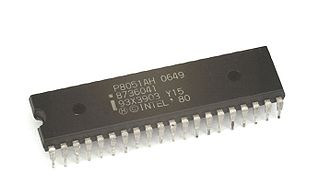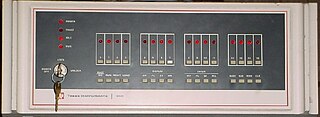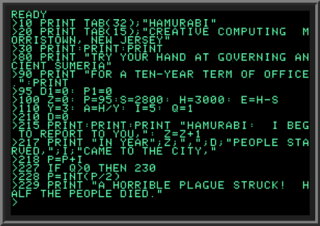Related Research Articles
Applesoft BASIC is a dialect of Microsoft BASIC, developed by Marc McDonald and Ric Weiland, supplied with Apple II computers. It supersedes Integer BASIC and is the BASIC in ROM in all Apple II series computers after the original Apple II model. It is also referred to as FP BASIC because of the Apple DOS command FP used to invoke it, instead of INT for Integer BASIC.

The Apple II is a personal computer released by Apple Inc. in June 1977. It was one of the first successful mass-produced microcomputer products and is widely regarded as one of the most important personal computers of all time due to its role in popularizing home computing and influencing later software development.
In computer architecture, 8-bit integers or other data units are those that are 8 bits wide. Also, 8-bit central processing unit (CPU) and arithmetic logic unit (ALU) architectures are those that are based on registers or data buses of that size. Memory addresses for 8-bit CPUs are generally larger than 8-bit, usually 16-bit. 8-bit microcomputers are microcomputers that use 8-bit microprocessors.

The Intel MCS-51 is a single-chip microcontroller (MCU) series developed by Intel in 1980 for use in embedded systems. The architect of the Intel MCS-51 instruction set was John H. Wharton. Intel's original versions were popular in the 1980s and early 1990s, and enhanced binary compatible derivatives remain popular today. It is a complex instruction set computer with separate memory spaces for program instructions and data.

Atari BASIC is an interpreter for the BASIC programming language that shipped with Atari 8-bit computers. Unlike most American BASICs of the home computer era, Atari BASIC is not a derivative of Microsoft BASIC and differs in significant ways. It includes keywords for Atari-specific features and lacks support for string arrays.
Microsoft BASIC is the foundation software product of the Microsoft company and evolved into a line of BASIC interpreters and compiler(s) adapted for many different microcomputers. It first appeared in 1975 as Altair BASIC, which was the first version of BASIC published by Microsoft as well as the first high-level programming language available for the Altair 8800 microcomputer.
Apple DOS is the disk operating system for the Apple II computers from late 1978 through early 1983. It was superseded by ProDOS in 1983. Apple DOS has three major releases: DOS 3.1, DOS 3.2, and DOS 3.3; each one of these three releases was followed by a second, minor "bug-fix" release, but only in the case of Apple DOS 3.2 did that minor release receive its own version number, Apple DOS 3.2.1. The best-known and most-used version is Apple DOS 3.3 in the 1980 and 1983 releases. Prior to the release of Apple DOS 3.1, Apple users had to rely on audio cassette tapes for data storage and retrieval.
Integer BASIC is a BASIC interpreter written by Steve Wozniak for the Apple I and Apple II computers. Originally available on cassette for the Apple I in 1976, then included in ROM on the Apple II from its release in 1977, it was the first version of BASIC used by many early home computer owners.
Commodore BASIC, also known as PET BASIC or CBM-BASIC, is the dialect of the BASIC programming language used in Commodore International's 8-bit home computer line, stretching from the PET (1977) to the Commodore 128 (1985).

An index register in a computer's CPU is a processor register used for pointing to operand addresses during the run of a program. It is useful for stepping through strings and arrays. It can also be used for holding loop iterations and counters. In some architectures it is used for read/writing blocks of memory. Depending on the architecture it may be a dedicated index register or a general-purpose register. Some instruction sets allow more than one index register to be used; in that case additional instruction fields may specify which index registers to use.
The Atari Microsoft BASIC and Atari Microsoft BASIC II variants of the 6502-version of Microsoft BASIC ported to the Atari 8-bit computers. The first version, released 1981, required 32 KB of RAM and was supplied on floppy disk. The second version, released the next year, had most of the code on a ROM cartridge with additional functions on an optional floppy.

The COSMAC is an 8-bit microprocessor family introduced by RCA. It is historically notable as the first CMOS microprocessor. The first production model was the two-chip CDP1801R and CDP1801U, which were later combined into the single-chip CDP1802. The 1802 represented the majority of COSMAC production, and today the entire line is known simply as the RCA 1802.
In computer engineering, an orthogonal instruction set is an instruction set architecture where all instruction types can use all addressing modes. It is "orthogonal" in the sense that the instruction type and the addressing mode may vary independently. An orthogonal instruction set does not impose a limitation that requires a certain instruction to use a specific register so there is little overlapping of instruction functionality.

The Clipper architecture is a 32-bit RISC-like instruction set architecture designed by Fairchild Semiconductor. The architecture never enjoyed much market success, and the only computer manufacturers to create major product lines using Clipper processors were Intergraph and High Level Hardware, although Opus Systems offered a product based on the Clipper as part of its Personal Mainframe range. The first processors using the Clipper architecture were designed and sold by Fairchild, but the division responsible for them was subsequently sold to Intergraph in 1987; Intergraph continued work on Clipper processors for use in its own systems.

The Western Design Center (WDC) 65C02 microprocessor is an enhanced CMOS version of the popular nMOS-based 8-bit MOS Technology 6502. It uses less power than the original 6502, fixes several problems, and adds new instructions. The power usage is on the order of 10 to 20 times less than the original 6502 running at the same speed; its reduced power consumption has made it useful in portable computer roles and industrial microcontroller systems. The 65C02 has also been used in some home computers, as well as in embedded applications, including implanted medical devices.
Lazer's Interactive Symbolic Assembler (Lisa) is an interactive 6502 assembler for Apple II computers written by Randall Hyde in the late 1970s.

The TI-990 was a series of 16-bit minicomputers sold by Texas Instruments (TI) in the 1970s and 1980s. The TI-990 was a replacement for TI's earlier minicomputer systems, the TI-960 and the TI-980. It had several unique features, and was easier to program than its predecessors.
The Capricorn family of microprocessors was developed by Hewlett-Packard in the late 1970s for the HP Series 80 scientific microcomputers. Capricorn was first used in the HP-85 desktop BASIC computer, introduced in January 1980. Steve Wozniak was inspired to build the Apple to be a computer like the HP 9830, and in 1976, he offered HP rights to the Apple computer. He was turned down and was given a release. When the calculator division started an 8-bit computer project called Capricorn, he left for Apple when he was not allowed to work on that project.

The W65C816S is a 16-bit microprocessor (MPU) developed and sold by the Western Design Center (WDC). Introduced in 1985, the W65C816S is an enhanced version of the WDC 65C02 8-bit MPU, itself a CMOS enhancement of the venerable MOS Technology 6502 NMOS MPU. The 65C816 is the CPU for the Apple IIGS and, in modified form, the Super Nintendo Entertainment System.

A BASIC interpreter is an interpreter that enables users to enter and run programs in the BASIC language and was, for the first part of the microcomputer era, the default application that computers would launch. Users were expected to use the BASIC interpreter to type in programs or to load programs from storage.
References
- 1 2 3 4 Wozniak, Stephen (November 1977). "SWEET16: The 6502 Dream Machine". Byte . Retrieved 2011-01-05.
- ↑ Apple Programmers Aid (PDF). Apple. 1978.
- ↑ Wozniak, Stephen (May 1977). "The Apple II" (PDF). Byte . Retrieved 2012-05-18.